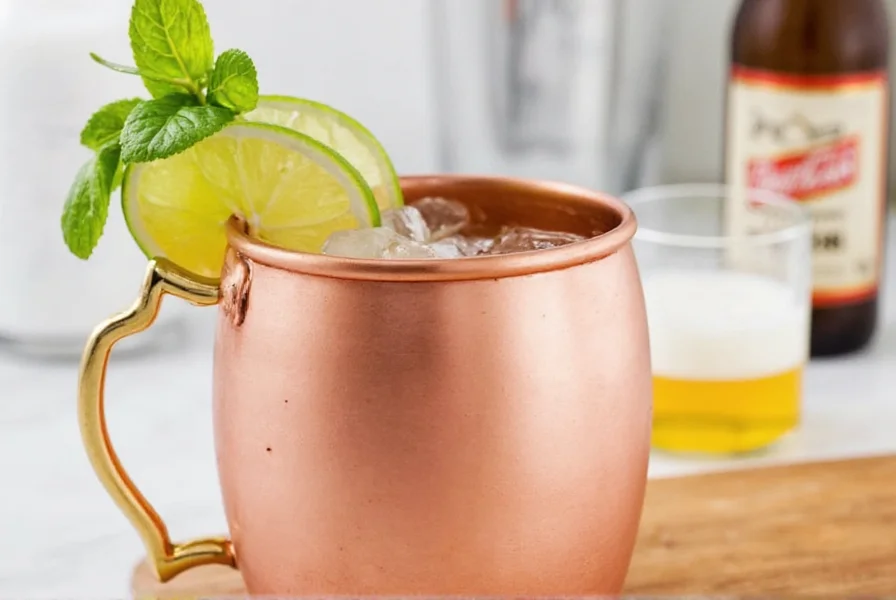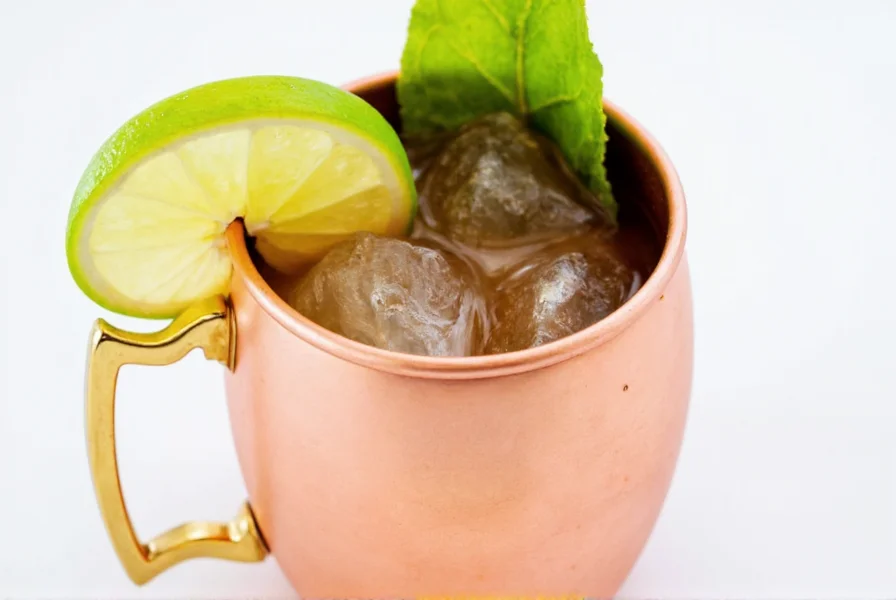While many confuse it with the traditional Moscow mule, the ginger beer mule stands apart through its use of authentic ginger beer—which contains real ginger root extract—delivering a more complex, spicy-sweet flavor profile. This distinction transforms the drinking experience, offering deeper warmth and subtle heat that ginger ale simply cannot match.
The Essential Components of a Perfect Ginger Beer Mule
Creating an exceptional ginger beer mule requires understanding each component's role. Unlike its Moscow mule cousin, the ginger beer mule relies on premium ingredients to shine through. The quality of your ginger beer dramatically impacts the final result—opt for craft brands with visible ginger sediment and minimal added sugar for authentic spice.
| Ingredient | Traditional Moscow Mule | Ginger Beer Mule Variation |
|---|---|---|
| Ginger Component | Ginger ale (mild, sweet) | Ginger beer (spicy, robust) |
| Ginger Intensity | Mild (2-3 on scale of 10) | Medium-high (6-8 on scale of 10) |
| Sugar Content | Higher (20-30g per serving) | Lower (10-15g per serving) |
| Alcohol Base | Vodka (standard) | Vodka (premium recommended) |
Step-by-Step Preparation Guide
Follow these professional techniques to craft the perfect ginger beer mule at home. The copper mug isn't just traditional—it actually enhances the drinking experience by maintaining optimal temperature while subtly interacting with the citrus components.
- Chill your copper mug in the freezer for 15 minutes before preparation
- Add 2 oz (60ml) premium vodka to the mug
- Squeeze 0.75 oz (22ml) fresh lime juice directly into the mug
- Add 4-6 ice cubes to chill without excessive dilution
- Gently pour 4 oz (120ml) craft ginger beer down the side of the mug
- Stir once with a bar spoon to integrate components
- Garnish with a lime wedge and thin ginger slice
This precise ginger beer mule ratio balances the spicy ginger notes with the clean vodka base and bright citrus. Many home mixologists make the mistake of over-icing or using low-quality ginger beer, which dilutes the ginger character and creates an unbalanced drink.
Advanced Techniques for Flavor Enhancement
For those seeking to elevate their homemade ginger beer mule, consider these professional bartender techniques. Adding a single drop of aromatic bitters creates complexity without overpowering the ginger profile. Some mixologists recommend lightly muddling a small piece of fresh ginger root in the mug before adding other ingredients for an extra layer of fresh ginger flavor.
Temperature control proves critical—serve between 38-42°F (3-6°C) to maximize flavor perception. Warmer temperatures accentuate alcohol notes while colder temperatures suppress the nuanced ginger spice. The copper mug naturally maintains this ideal temperature range through its thermal conductivity.
Popular Variations and Substitutions
While purists prefer the classic preparation, numerous creative variations cater to different palates and dietary needs. For a non-alcoholic ginger beer mule alternative, replace vodka with equal parts strong-brewed hibiscus tea and a splash of lemon juice. This creates a sophisticated mocktail with similar complexity.
Seasonal variations include:
- Fall version: Add 0.25 oz spiced simple syrup (cinnamon, clove, allspice)
- Winter version: Float 0.5 oz cranberry juice for color and tartness
- Spring version: Substitute lime with equal parts lemon and grapefruit juice
- Summer version: Add 2-3 fresh basil leaves gently muddled in the mug
Food Pairing Recommendations
The ginger beer mule's spicy-citrus profile complements specific food pairings exceptionally well. Its ginger heat cuts through rich, fatty foods while the acidity balances salty flavors. Ideal pairings include:
- Asian cuisine (particularly Thai and Vietnamese dishes)
- Spicy grilled meats (the ginger cools the palate)
- Ceviche and other citrus-marinated seafood
- Sharp cheeses like aged cheddar or blue cheese
- Brunch items like eggs Benedict or smoked salmon
Avoid pairing with delicate fish or subtle-flavored vegetarian dishes, as the ginger beer mule's pronounced spice can overwhelm more delicate flavors.
Common Preparation Mistakes to Avoid
Even experienced home bartenders make critical errors when preparing ginger beer mules. The most frequent mistake involves using ginger ale instead of ginger beer, creating a fundamentally different drink with significantly less ginger character. Another common error is overfilling the copper mug, which prevents proper integration of ingredients.
Many enthusiasts add too much lime juice, creating an overly tart profile that masks the ginger complexity. The ideal ratio maintains balance where no single component dominates. Additionally, using warm ginger beer destroys the delicate carbonation and releases too much ginger heat too quickly.
Storage and Preparation Tips
For optimal results, store your ginger beer upright in the refrigerator for at least 24 hours before use. This allows sediment to settle while maintaining carbonation. When selecting ginger beer, look for brands listing "fresh ginger" or "ginger root" as an early ingredient, avoiding those with "ginger flavor" or artificial ingredients.
Prepare ingredients in advance when hosting: juice limes the morning of your event and store in an airtight container, chill copper mugs, and keep ginger beer refrigerated until ready to serve. Never shake a ginger beer mule—this releases too much carbonation and creates an overly foamy drink.

Understanding Ginger Beer Quality Indicators
Not all ginger beers work equally well in a ginger beer mule. The best options display visible sediment when held to light, indicating real ginger content rather than artificial flavoring. Check the ingredient list—premium ginger beers list ginger root extract as a primary component, often with minimal added sugar.
Avoid ginger beers with high-fructose corn syrup or artificial preservatives, as these create an unbalanced sweetness that overwhelms the cocktail's complexity. The ideal ginger beer for mule cocktails should have a noticeable spicy kick that lingers on the palate without being overwhelmingly hot.
What's the difference between a ginger beer mule and Moscow mule?
The primary difference lies in the ginger component. A traditional Moscow mule uses ginger ale, which is milder, sweeter, and less spicy. A ginger beer mule uses authentic ginger beer made with real ginger root, delivering a more robust, spicy flavor profile with pronounced heat and complexity. This creates a noticeably different drinking experience with deeper ginger character.
Can I make a non-alcoholic version of a ginger beer mule?
Yes, you can create an excellent non-alcoholic ginger beer mule alternative by replacing the vodka with equal parts strong-brewed hibiscus tea and a splash of lemon juice. For added complexity, include a dash of aromatic bitters. The ginger beer's natural spice and carbonation provide the signature kick without alcohol.
Why must a ginger beer mule be served in a copper mug?
Copper mugs aren't just traditional—they serve functional purposes. Copper's excellent thermal conductivity maintains the ideal drinking temperature (38-42°F), while the metal subtly interacts with the citrus components to enhance flavor perception. The mug also creates a distinctive presentation that has become synonymous with the drink's identity.
How can I make my homemade ginger beer mule less sweet?
To reduce sweetness in your ginger beer mule, select a craft ginger beer with lower sugar content (look for brands with 10-15g sugar per serving). You can also increase the lime juice ratio slightly (up to 1 oz) to balance sweetness with acidity, or add a small pinch of salt which counteracts perceived sweetness without altering the recipe significantly.
What are the best food pairings for a ginger beer mule?
Ginger beer mules pair exceptionally well with Asian cuisine, particularly Thai and Vietnamese dishes, as the ginger complements curry spices. They also work beautifully with spicy grilled meats (the ginger cools the palate), ceviche, sharp cheeses like aged cheddar, and brunch items like eggs Benedict. Avoid pairing with delicate fish or subtle vegetarian dishes that the ginger's spice might overwhelm.
Frequently Asked Questions
What's the difference between a ginger beer mule and Moscow mule?
The primary difference lies in the ginger component. A traditional Moscow mule uses ginger ale, which is milder, sweeter, and less spicy. A ginger beer mule uses authentic ginger beer made with real ginger root, delivering a more robust, spicy flavor profile with pronounced heat and complexity. This creates a noticeably different drinking experience with deeper ginger character.
Can I make a non-alcoholic version of a ginger beer mule?
Yes, you can create an excellent non-alcoholic ginger beer mule alternative by replacing the vodka with equal parts strong-brewed hibiscus tea and a splash of lemon juice. For added complexity, include a dash of aromatic bitters. The ginger beer's natural spice and carbonation provide the signature kick without alcohol.
Why must a ginger beer mule be served in a copper mug?
Copper mugs aren't just traditional—they serve functional purposes. Copper's excellent thermal conductivity maintains the ideal drinking temperature (38-42°F), while the metal subtly interacts with the citrus components to enhance flavor perception. The mug also creates a distinctive presentation that has become synonymous with the drink's identity.
How can I make my homemade ginger beer mule less sweet?
To reduce sweetness in your ginger beer mule, select a craft ginger beer with lower sugar content (look for brands with 10-15g sugar per serving). You can also increase the lime juice ratio slightly (up to 1 oz) to balance sweetness with acidity, or add a small pinch of salt which counteracts perceived sweetness without altering the recipe significantly.
What are the best food pairings for a ginger beer mule?
Ginger beer mules pair exceptionally well with Asian cuisine, particularly Thai and Vietnamese dishes, as the ginger complements curry spices. They also work beautifully with spicy grilled meats (the ginger cools the palate), ceviche, sharp cheeses like aged cheddar, and brunch items like eggs Benedict. Avoid pairing with delicate fish or subtle vegetarian dishes that the ginger's spice might overwhelm.











 浙公网安备
33010002000092号
浙公网安备
33010002000092号 浙B2-20120091-4
浙B2-20120091-4